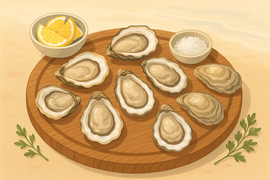In oyster farming, keeping oysters at the right temperature is essential for freshness and safety. Here's a quick breakdown of how cold chain management works from harvest to delivery:
- Harvest Cooling: Oysters are chilled immediately after being collected to stop bacterial growth.
- Processing & Storage: They are stored in a cold, controlled environment to maintain quality.
- Packaging & Transport: Special packaging and refrigerated vehicles keep them cool during shipping.
- Delivery Checks: Temperatures are verified upon arrival to ensure safety standards are met.
Proper cold chain management, like the practices at Little Wicomico Oyster Co., ensures oysters stay safe, fresh, and delicious. Using tools like thermometers, data loggers, and insulated containers, along with employee training, helps maintain these standards.
Main Elements of Oyster Cold Chain
Temperature Control During Harvest
When oysters are harvested, they need to be cooled quickly to stop bacterial growth. At Little Wicomico Oyster Co., oysters are immediately placed into insulated containers filled with ice to ensure they cool down right away. In hotter weather, additional steps are taken, like adding more ice, minimizing any delays in refrigeration, and closely tracking temperatures. These steps help protect the oysters from heat and sudden temperature changes, creating the right conditions for safe processing and storage.
Processing and Storage Requirements
Once at the processing facility, oysters are kept in a climate-controlled environment to stay within safe refrigeration limits during cleaning and sorting. Little Wicomico Oyster Co. uses a specialized cold room system for their Blackberry® Reserve Oysters, maintaining the ideal conditions to keep them fresh and high-quality. Strict internal protocols are followed throughout the storage process, ensuring the oysters remain in top condition until they’re ready for shipping.
Shipping and Delivery Methods
For transportation, Little Wicomico Oyster Co. relies on specially designed packaging and refrigerated vehicles. These vehicles are equipped with systems to continuously monitor temperatures, ensuring the oysters stay fresh and safe during transit. This careful handling means the oysters arrive in perfect condition, ready to be enjoyed.
HACCP Guidelines for Temperature Control
Creating Temperature Control Plans
HACCP requires a structured approach to managing risks throughout the oyster cold chain. At Little Wicomico Oyster Co., temperature control plans focus on these three main areas:
- Risk Assessment: Start monitoring temperatures at the point of harvest to quickly chill oysters to safe levels.
- Critical Limits: Set clear temperature ranges and time limits for each stage - harvesting, cooling, storage, and processing - based on industry standards and local rules.
- Corrective Actions: If there’s a temperature issue, act immediately. Adjust conditions, evaluate the oysters, document the problem, and inform the team.
By combining these steps with strong monitoring systems, compliance with safety standards is maintained throughout the cold chain.
Temperature Monitoring Equipment
Accurate temperature tracking is essential. Use tools like data loggers, infrared thermometers, probe thermometers, and wireless sensors to monitor conditions in real time.
To ensure reliability, regularly calibrate and maintain the equipment. Check devices against known standards, integrate them with backup power systems, and set up alert mechanisms where possible. Keep detailed temperature logs to meet food safety regulations and HACCP requirements.
Business Impact of Cold Chain Management
Reducing Product Loss
Managing the cold chain effectively is key to minimizing losses in oyster farming. Maintaining the right temperature is crucial for keeping oysters fresh and extending their shelf life.
Proper temperature control helps to:
- Prevent Bacterial Growth: Cold temperatures slow down bacterial activity.
- Preserve Quality: Quick and consistent chilling keeps oysters' natural flavors and textures intact.
- Avoid Spoilage: Accurate temperature regulation ensures the oysters stay viable for longer.
At Little Wicomico Oyster Co., strict temperature protocols have been a cornerstone of their ability to deliver high-quality oysters. Beyond cutting losses, these measures ensure a consistently premium product.
Meeting Quality Standards
Maintaining steady temperatures is essential for ensuring oyster quality. This approach delivers two key outcomes:
Safety Compliance
- Cold temperatures help meet food safety regulations.
- Proper cold chain management aligns with HACCP guidelines.
Product Excellence
- Stable cooling retains the oysters' natural briny taste.
- Correct temperature control ensures the meat stays firm and fresh.
"Our family has been raising oysters on Virginia's Little Wicomico River for four generations. Our farm is our pride and joy. We hope you enjoy our harvest!" - Little Wicomico Oysters
Their dedication to quality is backed by advanced temperature monitoring systems and well-trained staff, ensuring happy customers and long-term success.
sbb-itb-5051793
Cold Chain Management Guidelines
Tools for Temperature Management
To maintain optimal conditions, you’ll need the following tools:
Core Temperature Monitoring
- Digital thermometers with waterproof probes
- Continuous data loggers
- Infrared thermometers
- Bluetooth-enabled sensors for remote tracking
Storage Equipment
- Commercial refrigeration units
- Insulated transport containers
- Ice machines
- Temperature-controlled holding tanks
Documentation Tools
- Digital temperature logging software
- Recording charts
- Mobile apps for real-time tracking
- Calibration verification devices
It's equally important to ensure your team knows how to properly use these tools.
Training for Employee Temperature Control
Proper training for staff should include:
Temperature Management Basics
- Understanding the ideal temperature ranges for oysters
- Using monitoring tools correctly
- Identifying temperature danger zones
- Following emergency response protocols
Documentation Practices
- Recording accurate temperature readings
- Keeping detailed temperature logs
- Reporting any temperature issues
- Operating digital monitoring systems
Handling Procedures
- Quick harvesting to minimize temperature exposure
- Proper icing techniques
- Organizing storage efficiently
- Safe loading and unloading methods
This hands-on training is essential for maintaining cold chain standards and ensuring oysters meet the quality expectations of Little Wicomico Oyster Co. Employees are trained to handle equipment and follow protocols to keep oysters in top condition.
Quality Assurance Measures
- Regular calibration of equipment
- Verifying temperatures at critical points
- Implementing corrective actions when needed
- Maintaining cold chain integrity during transport
Summary: Cold Chain Management Basics
Managing the cold chain effectively ensures oysters stay fresh, last longer, and maintain your business's good reputation.
Temperature Control Essentials
- Keep oysters at a consistently safe, cool temperature during storage and transport.
- Monitor temperatures continuously from harvest to delivery.
- Use digital tools to log temperature data in real time.
- Act quickly to address any temperature changes.
Understanding the key stages helps pinpoint where strict temperature control is most critical.
Key Control Points
| Stage | Key Considerations | Critical Actions |
|---|---|---|
| Harvest | Oysters start to warm immediately | Cool or ice oysters right after collection. |
| Processing | Shift from harvest to controlled storage | Quickly transfer to refrigerated conditions. |
| Storage | Ensure a stable, cool environment | Regularly monitor storage temperatures. |
| Transport | Avoid temperature fluctuations | Use insulated containers and track temperatures. |
Steps for Consistent Quality
To maintain these standards, invest in the right equipment, train your team thoroughly, and keep a close eye on conditions at all times. Routine maintenance of refrigeration systems, ongoing employee training, and detailed record-keeping are essential to meeting food safety requirements and keeping oysters fresh. Even small temperature changes can impact both safety and quality.
At Little Wicomico Oyster Co., we prioritize strict cold chain management to ensure every oyster we deliver meets our high standards for freshness and excellence.
FAQs
What temperature ranges are required to keep oysters safe and fresh throughout the cold chain process?
Oysters must be kept at safe and consistent temperatures throughout the cold chain process to maintain their freshness and quality. Generally, they should be stored at 32°F to 40°F during transportation, storage, and distribution. Keeping oysters within this range helps prevent spoilage and ensures they remain safe to eat.
Always use reliable refrigeration and monitoring systems to maintain these temperatures at every stage of the cold chain. Proper handling and temperature control are critical to delivering the premium quality oysters customers expect.
How does Little Wicomico Oyster Co. maintain HACCP compliance in their oyster cold chain process?
Little Wicomico Oyster Co. adheres to strict HACCP (Hazard Analysis and Critical Control Points) guidelines to ensure the safety and quality of their oysters throughout the cold chain. This involves closely monitoring critical factors like temperature control, sanitation, and handling procedures at every step - from harvesting to delivery.
By maintaining proper refrigeration and implementing rigorous quality checks, they ensure their oysters remain fresh and safe for consumption. These practices not only meet regulatory standards but also reflect their commitment to delivering premium, sustainably farmed seafood to customers.
What are the risks of not maintaining the cold chain in oyster farming and distribution?
Failing to maintain the cold chain during oyster farming and distribution can lead to serious consequences. Temperature fluctuations may cause oysters to spoil, compromising their freshness, quality, and safety. This increases the risk of foodborne illnesses, which can harm consumers and damage trust in your product.
Additionally, improper cold chain management can result in financial losses due to waste, as spoiled oysters cannot be sold. Maintaining consistent refrigeration from harvest to delivery is essential to preserving the premium quality and flavor of oysters, like those offered by Little Wicomico Oyster Co.





